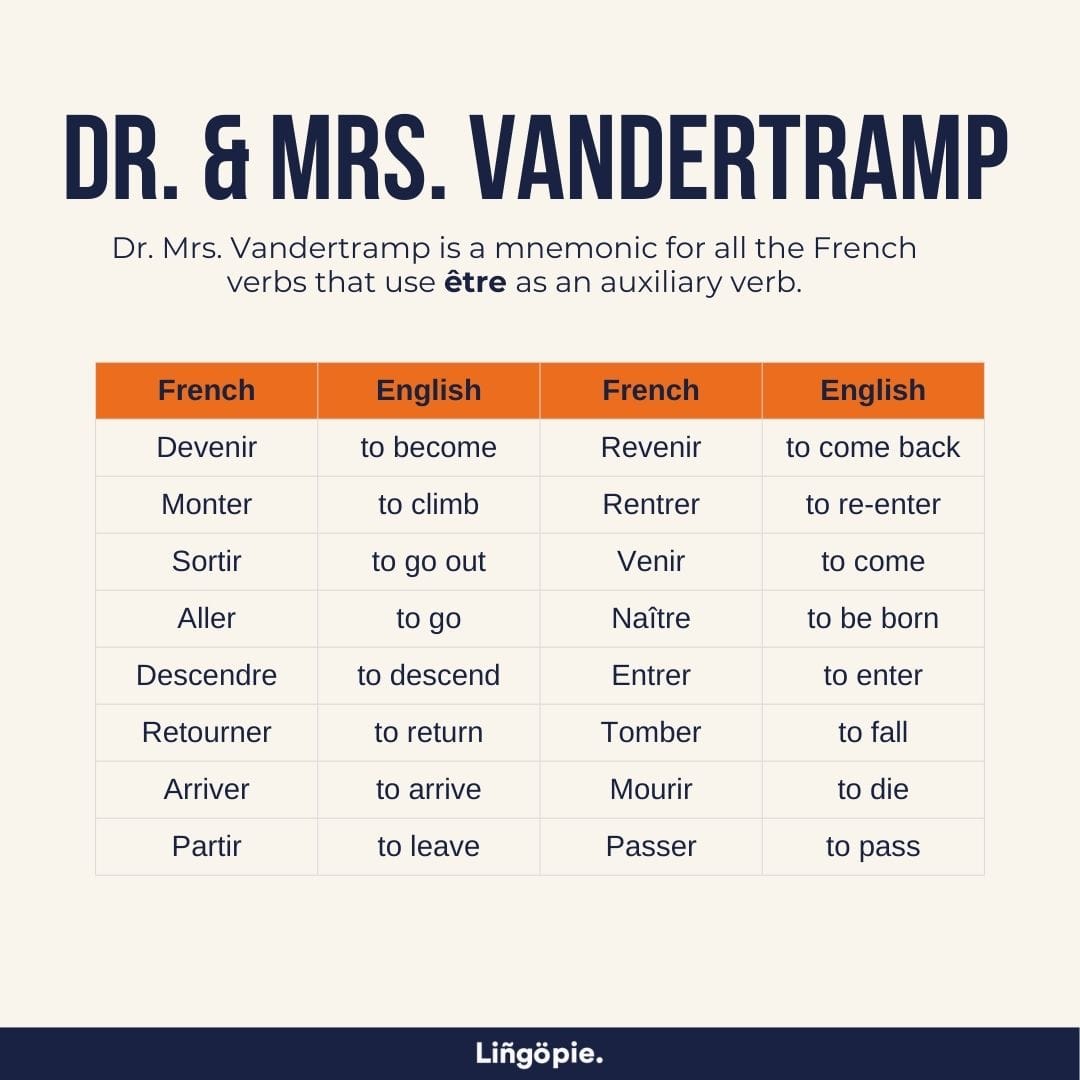Do you know Dr. Mrs.Vandertramp? I remember sitting in my high school French class when the teacher announced, "Today, we’re going to meet Dr. Mrs. Vandertramp."
Everyone turned to the door, waiting for some mysterious figure to walk in. But instead of a person, we were introduced to a set of verbs—verbs that would forever change the way we conjugate in French.
In this article, we’ll break down the process of mastering Dr. Mrs. Vandertramp verbs into three simple steps. You’ll first understand what these verbs are and why they’re different. Then, we’ll share easy ways to memorize them using mnemonics and practical tips.
By the end, you’ll have everything you need to use these verbs in French conversation and writing confidently. Read on and improve your French!
- 11+ Funny French Expressions That’ll Surprise You
- 5 French Accent Marks You Need To Know
- 9 Best Short Stories In French For Beginners

Step 1: Understand The Basics Of Dr. Mrs. Vandertramp Verbs
Learning Dr. Mrs. Vandertramp verbs is key to mastering French past tense. These verbs follow different rules, but once you know why, it’s much easier to use them. In this section, we’ll explain what makes these verbs special and how to use them correctly with être.
What Is Dr. Mrs. Vandertramp?
Dr. Mrs. Vandertramp is a mnemonic technique or strategy created to help French learners remember 17 specific French verbs conjugated with the auxiliary verb être in the passé composé (past tense) instead of the more common auxiliary verb avoir.
A primary characteristic of these verbs is that they usually involve movement or changing states. By using this handy acronym, you can easily remember these verbs when writing or speaking in French.
Here’s the full list of Dr. Mrs. Vandertramp verbs, along with their English translations:
- Descendre (to go down)
- Rentrer (to return home)
- Monter (to go up)
- Rester (to stay)
- Sortir (to go out)
- Venir (to come)
- Arriver (to arrive)
- Naître (to be born)
- Devenir (to become)
- Entrer (to enter)
- Retourner (to return)
- Tomber (to fall)
- Revenir (to come back)
- Aller (to go)
- Mourir (to die)
- Partir (to leave)

Why Are These Verbs Different?
Most French verbs in the passé composé take avoir as their auxiliary verb (e.g., J'ai mangé - I ate). However, the Dr. and Mrs. Vandertramp verbs are exceptions to this rule because they use the verb être (e.g., Je suis allé - I went).
What makes these verbs stand out? They typically describe movement or a change in state, which explains why être is used, as it reflects the idea of "being" or "becoming" something in the past. For example:
- Monter (to go up) indicates movement.
- Naitre (to be born) signifies a state change.
This distinction is important because it affects how the past participle is formed. When we use être, the subject and past participle must agree in gender and number, which isn't the case when conjugating with avoir.
So, understanding why these verbs are different helps ensure your French conjugations are correct, especially in more complex sentences.
@salvetutoring #frenchgcse #drmrsvandertramp #languages #foryour #fyp
♬ original sound - Salve Tutoring
Step 2: Memorize The Verbs With Mnemonics And Practice
Now that you know which verbs are part of Dr. Mrs. Vandertramp, it's time to memorize them. This step will help you remember each verb and use it correctly. We’ll break down the acronym into manageable pieces and share some tricks to make memorizing easier and more fun.
Breaking Down The Acronym
When you're memorizing the Vandertramp verbs, it's helpful to break down the acronym and visualize how each letter corresponds to a verb. Here's a detailed look:
- D - Descendre (to descend)
Example: Nous sommes descendus du bus. (We got off the bus.) - R - Retourner (to return)
Example: Elle est retournée à la maison. (She returned home.) - M - Monter (to go up)
Example: Ils sont montés au sommet de la montagne. (They went up to the top of the mountain.) - R - Rester (to stay)
Example: Je suis resté à l'hôtel. (I stayed at the hotel.) - S - Sortir (to go out)
Example: Vous êtes sortis avec vos amis. (You went out with your friends.) - V - Venir (to come)
Example: Il est venu à la fête. (He came to the party.) - A - Arriver (to arrive)
Example: Elles sont arrivées en avance. (They arrived early.) - N - Naître (to be born)
Example: Mon frère est né en janvier. (My brother was born in January.) - D - Devenir (to become)
Example: Elle est devenue médecin. (She became a doctor.) - E - Entrer (to enter)
Example: Nous sommes entrés dans la salle. (We entered the room.) - R - Revenir (to come back)
Example: Il est revenu de son voyage. (He came back from his trip.) - T - Tomber (to fall)
Example: Ils sont tombés de vélo. (They fell off the bike.) - R - Rentrer (to return)
Example: Je suis rentré chez moi. (I returned home.) - A - Aller (to go)
Example: Tu es allé au marché. (You went to the market.) - M - Mourir (to die)
Example: Le chien est mort hier. (The dog died yesterday.) - P - Partir (to leave)
Example: Elle est partie en vacances. (She left for vacation.)

Mnemonic Tricks For Faster Recall
Memorizing all 17 verbs can be challenging, but there are several mnemonic techniques to help with retention:
Visual Resources:
~Create a visual chart or infographic that illustrates each verb with a corresponding image. You can also use color coding to differentiate between verbs and make the information more memorable.
Flashcards:
~Create flashcards with the verb on one side and its meaning and an example sentence on the other. This can be done physically or using apps like Quizlet or Anki.
~Include both the verb in its infinitive form and its conjugated form in passé composé to reinforce learning.
Songs And Rhymes:
~Find or create a song or rhyme that includes the verbs. Music and rhythm foster memorization by making the information more engaging and easier to recall.
Interactive Exercises:
~Use online quizzes and games designed to test your knowledge of Dr. Mrs. Vandertramp verbs. Interactive practice helps reinforce learning and makes the process enjoyable.
With these mnemonic tricks and regular practice, you'll become better at remembering and correctly using the Dr Mrs Vandertramp verbs.

Step 3: Learn The Conjugation And Agreement Rules
Now, it's time to get into the details of conjugation and agreement. This step will show you how to properly conjugate Dr. Mrs. Vandertramp verbs and make sure they match the subject's number and gender.
Verb Conjugation With Être
In French, verbs are generally conjugated with avoir in the passé composé, but Dr. Mrs. Vandertramp verbs are a notable exception; they use être. Here's how it works:
Difference Between Être And Avoir Verbs:
Être Verbs: These verbs often indicate movement or a change in state. They are conjugated with être in the passé composé, and the past participle must agree with the subject in gender and number.
Example: Elle est allée (She went).
Avoir Verbs: These are the majority of French verbs and are conjugated with avoir. In most cases, the past participle does not agree with the subject unless a direct object precedes it.
Example: Il a mangé (He ate).
Conjugating Dr. Mrs. Vandertramp Verbs In Passé Composé:
To conjugate these verbs, use the present tense of être followed by the past participle of the main verb. Here’s how you conjugate a few of them:
Aller (to go):
- Je suis allé(e) (I went)
- Tu es allé(e) (You went)
- Il/Elle est allé(e) (He/She went)
- Nous sommes allé(e)s (We went)
- Vous êtes allé(e)(s) (You went)
- Ils/Elles sont allé(e)s (They went)
Venir (to come):
- Je suis venu(e) (I came)
- Tu es venu(e) (You came)
- Il/Elle est venu(e) (He/She came)
- Nous sommes venu(e)s (We came)
- Vous êtes venu(e)(s) (You came)
- Ils/Elles sont venu(e)s (They came)
Gender And Number Agreement
An essential rule when using être with Dr. Mrs. Vandertramp verbs is to make sure they match the subject's number and gender.
Singular Subjects
For feminine singular subjects, add an -e to the past participle.
Example: Elle est arrivée (She arrived).
For masculine singular subjects, no additional ending is needed.
Example: Il est parti (He left).
Plural Subjects
For feminine plural subjects, add -es to the past participle.
Example: Elles sont parties (They (feminine) left).
For masculine plural subjects, add -s to the past participle.
Example: Ils sont partis (They (masculine) left).
Examples Illustrating Agreement Changes:
- Nous sommes montés (We went up) – if the subject is mixed or all male.
- Nous sommes montées (We went up) – if the subject is all female.
- La voiture est tombée (The car fell) – voiture is feminine singular, so tombée agrees with gender.
- Les voitures sont tombées (The cars fell) – voitures is feminine plural, so tombées agrees in number.
Learn More About French With Lingopie
Mastering Dr. Mrs. Vandertramp verbs does not have to be a headache. By following these three simple steps—understanding the basics, memorizing the verbs, and mastering the conjugation rules —you'll find yourself confidently using these verbs in no time.
Remember, consistent practice is key, and with patience, these verbs will become second nature to you over time.
To take your French learning even further, why not immerse yourself in real-life French movies? A fantastic resource for learning languages is Lingopie, a platform that allows you to watch TV shows and movies in French while learning the language.
By seeing Dr. Mrs. Vandertramp verbs and other French vocabulary used in authentic contexts, you will strengthen your learning. Ready to take the next step? Try Lingopie today and see how French grammar comes to life while enjoying your favorite content!
FAQ: Dr and Mrs Vandertramp French Verbs
What does "Dr and Mrs Vandertramp" stand for in French grammar?
"Dr and Mrs Vandertramp" is a mnemonic device created specifically for English-speaking French learners to remember the 17 verbs that take être (instead of avoir) as their auxiliary verb in compound past tenses like the passé composé. Each letter represents the first letter of these special verbs: Devenir (to become), Revenir (to come back), Mourir (to die), Retourner (to return), Sortir (to exit), etc.
How do I correctly form the passé composé with the Vandertramp verbs?
When using Dr and Mrs Vandertramp verbs in the passé composé, you must: 1) conjugate être in the present tense according to your subject (je suis, tu es, il/elle est, etc.), 2) add the past participle of your main verb (devenu, allé, tombé, etc.), and 3) make the past participle agree with the subject in gender and number (adding -e for feminine subjects and -s for plural subjects).
For example: "Elle est montée" (She went up), "Ils sont arrivés" (They arrived), "Nous sommes allés" (We went). This agreement rule is a key difference from verbs that use avoir, where the past participle typically doesn't change to match the subject.
Are there exceptions or complications with these verbs?
Several Vandertramp verbs can actually take avoir instead of être in specific contexts, particularly when used with a direct object. For example, "monter" uses être when indicating someone went upstairs ("Je suis monté"), but uses avoir when something is being carried up ("J'ai monté les valises" - I carried the suitcases up).
The same applies to "descendre," "sortir," "passer," and several others. Additionally, reflexive verbs (using "se") always take être regardless of whether they're on the Vandertramp list, functioning under similar agreement rules but forming a separate category.
What are some alternative ways to remember these verbs?
Many teachers and students have developed alternative memory techniques beyond the basic Vandertramp acronym. One popular method is "La Maison d'Être" (The House of Being), which visualizes these verbs as actions occurring around a house—entering (entrer), going upstairs (monter), going downstairs (descendre), leaving (sortir), etc.
Others use variations of the acronym like "Mrs P. Vandertramp" (including passer) or group the verbs by meaning rather than by acronym: verbs of vertical movement (monter/descendre), verbs of entrance/exit (entrer/sortir), verbs of coming/going (venir/aller), etc. Finding the method that works best for your learning style is key to mastering these special verbs.
Do native French speakers use this mnemonic?
Native French speakers are generally unfamiliar with "Dr and Mrs Vandertramp" since this mnemonic was created specifically for English-speaking French learners. French speakers naturally internalize which verbs take être through regular language exposure from childhood without needing conscious memorization techniques. The mnemonic appears to have originated in English-language French classrooms, possibly in the mid-to-late 20th century, though its exact origins remain somewhat unclear.








![Happy New Year In French: 10+ Best French Greetings [Guide]](/blog/content/images/size/w300/2024/12/Happy-New-Year-In-French.jpg)

